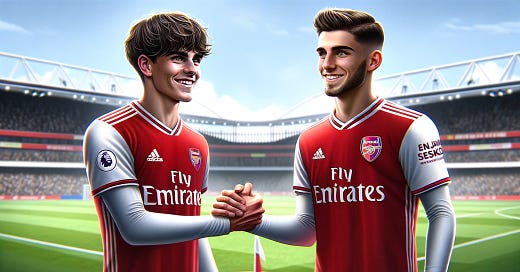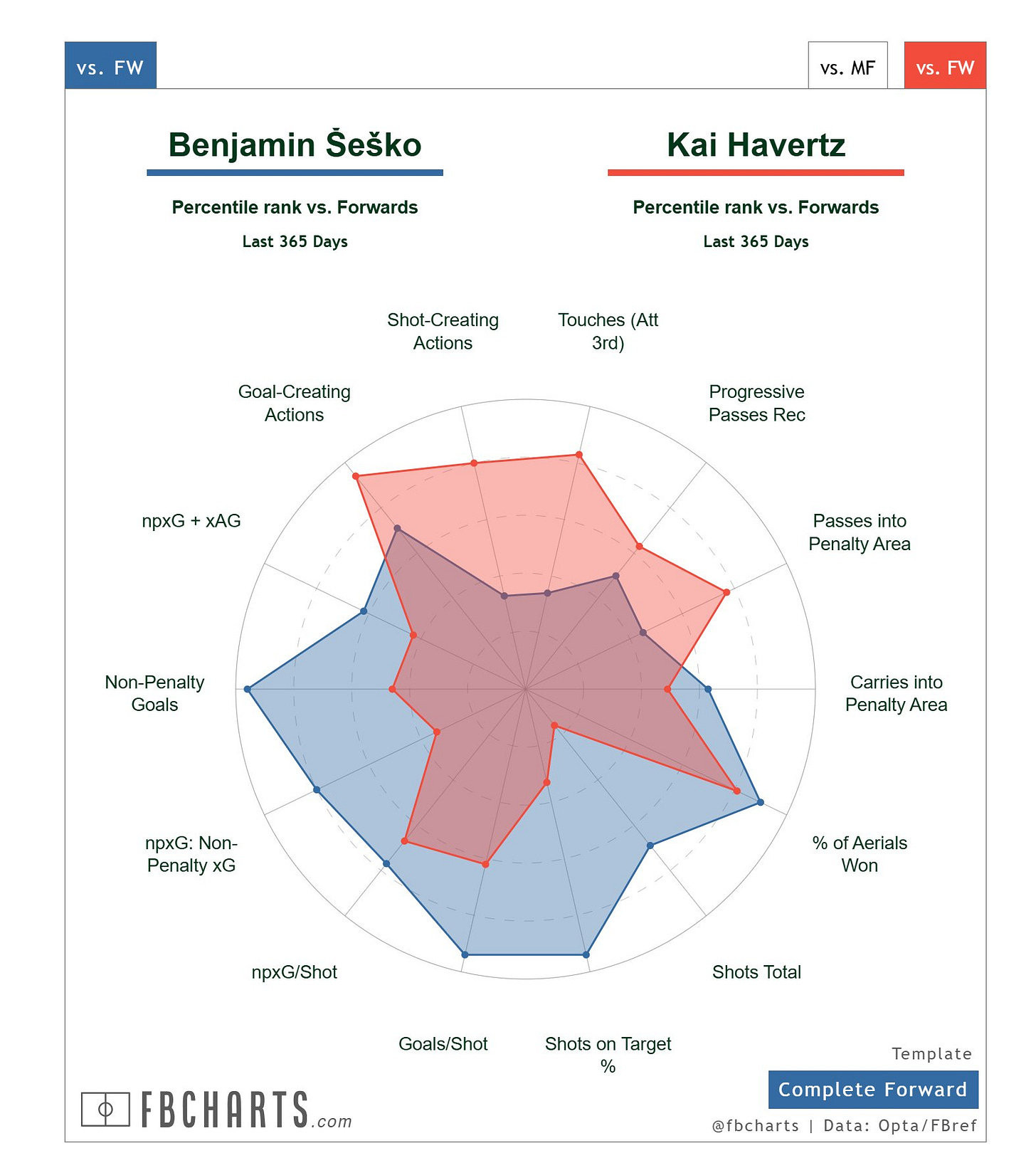#33 - Could Arsenal play Havertz and Sesko together?
Taking a look at tactical tweaks Arsenal could make to allow Havertz to play alongside another striker in certain games and how the two players differ.
Often we try and predict how Arsenal will line up with new signings, and the presumption is that if Arsenal are to sign a Benjamin Sesko, Ivan Toney or Viktor Gyokeres type-stirker, that it would be one of them or Kai Havertz leading the line. But what if Arteta is eyeing another evolution? Could we see Havertz utilise his midfield experience and play alongside another forward? I think it’s possible, at least for certain fixtures and in different game situations.
Obviously what you lose with this is a sense of ‘control’. But with some tactical shifts, Arsenal could re-establish that control through other structures.
Ultimately when Havertz was first introduced into the side, Arteta was trying to do just that. But after losing Partey and Timber to injuries, it didn’t quite work.
With the injuries to Partey, Timber and Oleksandr Zinchenko, Arsenal reverted to the likes of Kiwior and Tomiyasu at left-back for much of the season, therefore they surrendered a bit of control from deeper areas. This meant Declan Rice often had to start in the ‘8’ to support a Jorginho or Partey in build-up.
If Arsenal were to start the season with Jurrien Timber inverting from left back, he gives you this control in central zones back. He’s comfortable further forward, too.
You could then effectively build with a base of Rice and Timber as your pivot. This frees up the ‘left 8’ role to be more of that second striker role. This would allow Havertz to be back in this position.
Arsenal’s midfield can be very fluid in certain scenarios, and in this shape I’d expect something similar. Havertz often dropping deep to give the left side that support and link that Odegaard provides to the right-hand side. This could create a bit of a box midfield of Timber-Rice-Havertz-Odegaard and then a traditional front three ahead of them.
When opponents sit deep, Havertz could push on as a second centre forward, and suddenly as well as the technical brilliance threat provided by the likes of Odegaard, Saka and whoever is on the left, opposition defenders will have to try and stop two 6ft 4’ forwards. It would give the team so many potential avenues to breaking down oppositions.
Of course this wouldn’t be applicable to every game or game state, but it’s an option Arsenal could revert to when needed and considering when Arsenal dropped points last season, they often didn’t score, they probably do need to find a tactic like this to source goals in games where they are struggling.
The other side to this is the profiles of the two players. I’ve seen a lot of people suggest Sesko is effectively the same as Havertz and their thesis for this seems to be mainly because both players stand at 6ft 4’… but let’s take a closer look.
Comparing across leagues and considering Havertz has played a couple of different positions, stats here aren’t perfect. But there are quite a few things that highlight how they differ, and how both their presences in the side could compliment each other.
What we see from the above chart courtesy of FBCharts, via Opta/FBRef stats, is their strengths and weaknesses differ. Sesko is much stronger in his ball striking, and the quality of his shots are much better in all those metrics.
Sesko gives you that ‘fox in the box’ presence, whilst his pace also presents a counter-attacking threat, and it would enable Arsenal to take better advantage of some situations where Havertz struggled last season.
Both players are of course good in the air, but Havertz more so in his link play whilst Sesko takes more headed shots at goal.
Where Havertz is better is his touches per 90, goal-creating actions and general more ‘midfield’ play. This is why I think he could really work as the ‘fourth midfielder’ in a setup like the above, where Arsenal effectively dominate the middle with a box midfield on the ball and then split to more of a two-striker system when we progress the ball into wide areas. Havertz can then become the box-crashing second striker he excelled as at Leverkusen.
Playing as Arsenal’s number 9, he was still averaging around 30 passes a game, so in this role he would effectively he’d be playing in quite similar zones, just with an extra body ahead of him.
All of this is a strategy to get the football Arsenal are playing higher up the pitch.
This is something Arsenal have done really well over the last few years through tactical innovations and something like this could simply be the next evolution.







Great data backed insights 🔥
Thank you!